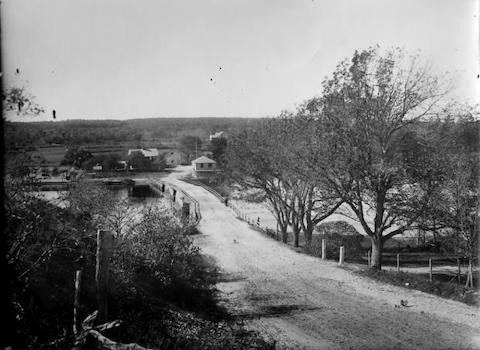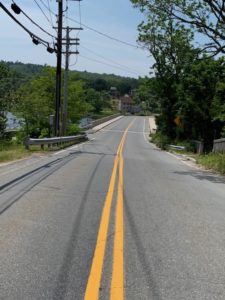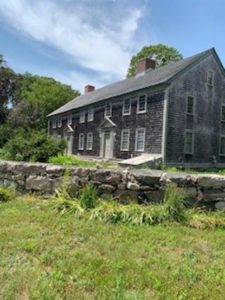The photo suggests a peaceful day in the country, but the accompanying story relates anything but. This is Hix Bridge, in Westport, MA, where Joseph Grinnell, a 16 year-old apprentice, encountered three enslaved fugitives attempting to reach a Quaker safe house in 1790s New Bedford. The grim and shocking account was excerpted in the Westport Historical Society newsletter, to which my husband subscribes, as we have a 1722 house, a half mile from the bridge. The story stunned me and changed forever how I see the quiet, bucolic place to which my family escapes on weekends. A dark history came into focus, but I welcomed it.
Grinnell relates how, after meeting the three fugitives whom he recognized as “belonging” to someone he knew, he did his best to set them on the right path to the Shakers, and “bid them scratch gravel for their lives.” Soon afterwards, he ran into Samuel Anthony, the Sheriff of Newport, RI, who was on the hunt for the runaways and to whom he lied about seeing them.
I had a very nice whale-bone whip in my hand I had given me in New Bedford, which he took (Altho’ I objected to it) without giving me half its value – I tried as hard as I could to detain him, to give the poor devils a good start. Fortunately the three negros, arrived before Anthony, and put themselves in the care and protection of the quakers.
The Sherriff, on his arrival was soon informed of their whereabouts, and made no delay in presenting himself before them in his official character, calling them by name Moses, Jack &c. you are my prisoners, at the same time biding them to follow him. The poor fellows not knowing better was about to obey, when the people interfered.
The news had spread like wild-fire and the inhabitance was determined to release them from the Sheriff’s clutches, and from the bonds on slavery They took the negroes from him, – cut off his horses tail as near his body as they could, – sheared his mane, close to the poor animals neck and not feeling satisfied they cruelly cut his ears off almost even with its head, – tore off the sheriffs cot, and many other annoyances commit, until they had allayed their agitated feelings, and then bid him take tracks for Rhode Island, as fast as his poor beast could carry him.
The account was dictated 66 years after the event and are the words of an old man. It suggests the flawed nature of many of those involved and thus feels very real to me. Grinnell finds time to complain about the loss of his whip and fails to see the fugitives as the very brave individuals they had to have been, but he helps them. The crowd, who prevented the sheriff from seizing the three runaways, “allayed their agitated feelings” by savaging the innocent horse. We get a glimpse of mob brutality, even among the abolitionist champions. The newsletter, written by Jenny O’Neill, the society’s Executive Director, mentions that the owners of a house a few hundred feet up from the bridge—still existing and on my road—had owned slaves. She ends by mentioning that Grinnell may have sympathized with the fugitives in this account but still shipped out on a slaver ship as an adult.
I’ve always known that slavery existed in the North, but I’d always associated the Underground Railroad with the South. In truth, I’d never imagined that people in Westport had slaves or that when Massachusetts abolished slavery before Rhode Island, around the time of this story, the border between the two states—which I cross many times a day without even knowing it—was once a matter of life or death for many. With the puncturing of my naïveté, the layers of history collapsed. Now, every time I cross the bridge, I will see those three desperate men seeking help from a boy. Slavery may have ended in my state 230 years ago, but the past is never truly gone. Nor should it be forgotten.
Like many people watching the TV series, The Underground Railroad, I’ve been learning just how harrowing it was to attempt escape. Last year my bookclub read the book by Colson Whitehead on which the series is based, and I have spent time contemplating Dawoud Bey’s Underground Railway series in his current Whitney Museum exhibit. The TV series is horrifying in its graphic sadism, and Bey’s photos effectively evoke the terror that fugitives would have endured as they made their way towards freedom. Many Americans are currently trying to imagine this shameful aspect of our country’s history, so as to better grasp its meaning.
I have no direct responsibility for slavery; my house was standing when these events took place, but my Jewish ancestors were in Europe trying to survive the terrors of the pogroms and never owned slaves themselves. And yet I feel guilty that my country embraced and institutionalized slavery and, now, that some in my neighborhood once profited from it. My identification as an American and as a Westporter brings that sense of guilt.
It is not illusory. We can’t help but benefit from past exploitation, inadvertently and indirectly, perhaps, but inevitably, all the same. One person’s unfair treatment makes it easier for many others, and the consequence of that injustice continues to impact the lives of all their descendants. We need to understand better what was suffered in order to appreciate better what is owed.
Guilt is uncomfortable, and we struggle to expiate it. One way is to use our imaginations to bridge the gap between others then and ourselves today, trying to get into the minds of past victims, to feel what they felt when they lived their experience. The more we can identify with someone the more we empathize—and the further we get from the perpetrator. The scene on Hix Bridge and what followed are disturbing to contemplate, but they connect me to the reality of a place I’d mistakenly thought I knew. However terrible the events that transpired there, it feels right to keep them alive in my mind.



And illuminating and thought-provoking story. You were writing is always so clear and perceptive.
Thank you Liz.
Great story and great insights.
Great story! Now I too am ‘doomed’ to remember these events every time I cross that bridge! (oh man. .. ..)
Thanks for retelling this story and its impact on you. History is most powerful when it touches us personally. Several years ago, my husband and I found the home of his great-great grandfather in Winsted, CT. The man had been an abolitionist leader in his town in the 1840s, and his house had been a station on the underground railroad. It even had a tunnel to the next station. For me, that experience brought history alive.
And thanks for your story, Liz. What you say is so true: the closer it is, the more real.